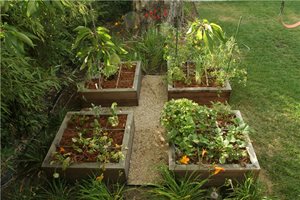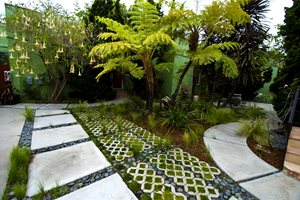Vegetable Garden Design Tips
Ideas for incorporating a food garden into your home landscape By Maureen Gilmer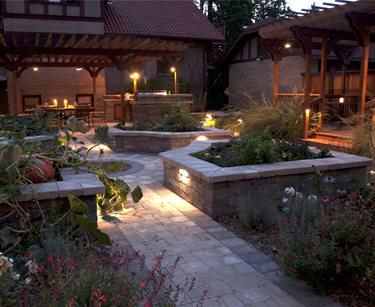
Lighting
Design night lighting into high profile food gardens so they're safe and accessible after dark.
This four square garden features all the important elements that make versatile planting for highly visible outdoor living spaces. The quadrant design is age old, rooted in the French potager and old monastic cloisters that never go out of style. The lighting here is not only ornamental, it makes it possible to pick herbs and greens after dark without using a cumbersome flashlight. The incorporation of a wide flat cap and raised planters set at seatwall height double as overflow seating while entertaining large groups. This seatwall also facilitates gardening for the physically challenged who need to rest while they pick and weed.
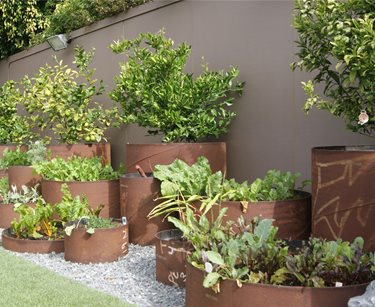
Steel pipe planters
Avoid dry rot from earth-to-wood contact with steel planters made from industrial pipe.
The long time problem with raised beds constructed of wood is extensive from earth-to-wood contact that inevitably rots out. The weight of the soil inside raised beds becomes even heavier when saturated, causing wood planters weakened by rot can fail during the rainy season. The reason for introducing steel into this application is to avoid future replacements with a visually appealing alternative. However, this may be fine in cool climates, but further south steel absorbs tremendous heat during the day. This prevents the soil mass from cooling down at night, subjecting the root zone to abnormally high temperatures around the clock.
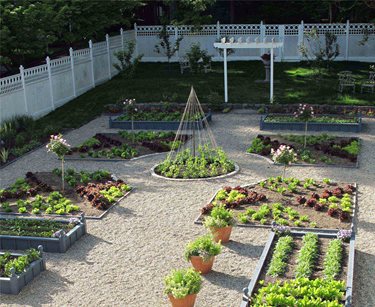
Potager
Design a French potager when a food garden is seen from second story views.
The traditional French potager is a simple pattern of beds that is traditional throughout Europe. It evolved from elaborate parterres lined with hedges to be viewed from upper stories of a chateux. Within the beds, patterns are created by arranging vegetable plants in various colors to create geometric lines and fields. Here a simple modern potager is made ornamental by the way plants are set out into each individual planting area. Such a precise design is ideal for colored lettuce varieties, the cabbage family and other low plants that make a solid mass. However, this precision will not last far into summer when the heat drives when these tidy leafy plants to lose their beauty as they bolt to flower.
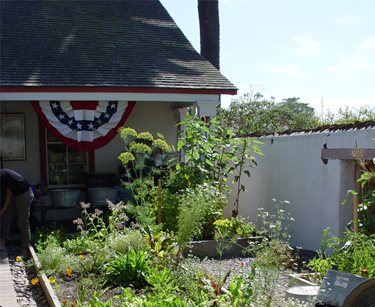
Design for summer
Blend flowers into the high profile food garden to soften the look late in the season.
Vegetable gardens may look great in spring when all the plants are small and trim, but they won't remain that way for long. Planting edible flowers and herbs into the vegetable plot helps to disguise the older lanky squash and tomatoes with large flowering perennials such as fennel and chamomile. The more diverse the flowering plants are, the less you'll notice hard working veggies that are still producing, but not at their peak. This integration of a more diverse group of plants is important anywhere the vegetable garden is in the front yard, or up close in the backyard where it's seen in detail from outdoor living spaces.
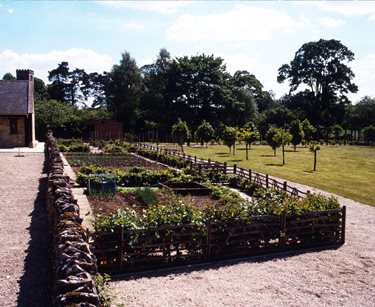
Tidy fencing
Large in-ground vegetable gardens deserve attractive fencing with generously wide gates.
This is the ideal vegetable garden for the larger flat homesite where it is spread out over a generous area. In-ground gardening is more versatile than detiled beds so a rototiller can easily work the soil overall. This fencing is so visually attractive it turns the rectangle into a beautiful enclosure which features various sized gates. It is vital to include a very wide double gate with vehicular access to allow a truck to dump large quantities of mulch and compost. This saves the laborious process of bringing it in by the wheelbarrow load.
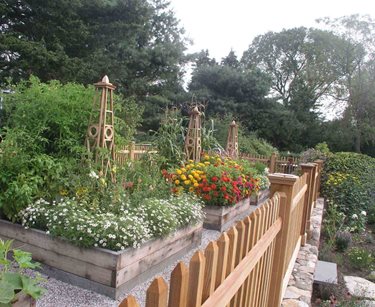
Interesting details
Design period details into a food garden to link to a house with historic charm.
When a home is historic, or merely vintage, bring this character into the food garden with picket fencing and beautifully crafted wood towers that double as treillage for climbing vegetables. The designer repeated this vertical element to make each of these identical raised beds a miniature landscape of its own. A south facing exposure has plants arranged by height to ensure all receive plenty of sun. Here, all wood elements are left to weather naturally so that in time the entire character of the garden will look just as old as the house itself.
See more food garden pictures

 Backyards
Backyards
 Front Yards
Front Yards
